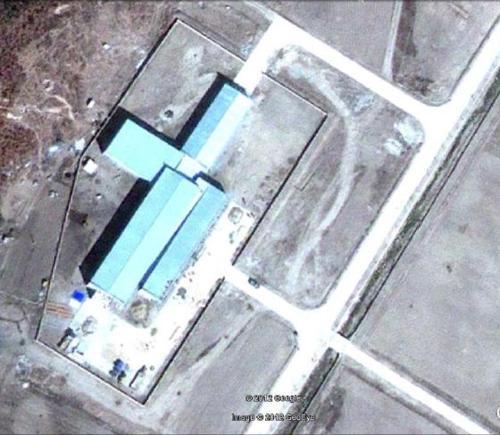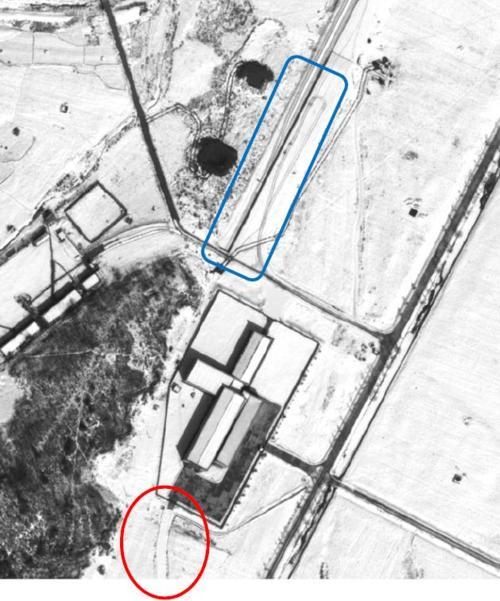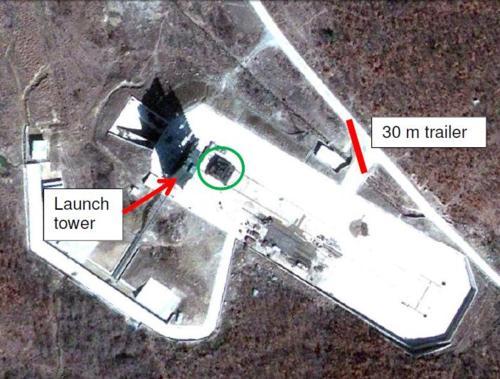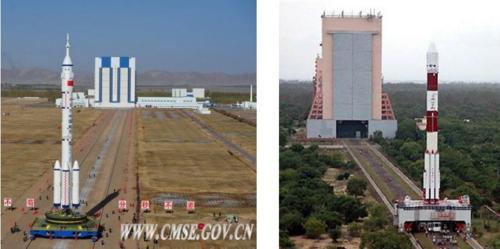
Figure 1. The Missile Assembly Building at Tongch’ang-dong (Image from Google Earth, March 25, 2009).
I have been looking at options for how North Korea could get its rocket to the launch pad and ready for launch at the Tongch’ang-dong site. My conclusion is that the stages of the rocket will likely be transported separately and assembled on the pad, as North Korea apparently did in preparation for its April 2009 launch at the Musudan launch site. However, Pyongyang may be planning for a different process in the future.
Tim Brown at globalsecurity.org has identified a building 1,000 meters north of the launch pad at Tongch’ang-dong as the “missile assembly building.” This building is shown in Figure 1 in a 2009 image from Google Earth. The main part of the building is about 55 meters long, and would therefore be large enough to assemble the full Unha launcher, which is approximately 30 meters long.
Press reports on Monday quoted the South Korean Defense Ministry as saying that North Korea has moved the main body of the rocket into a building at the launch site, presumably referring to the building in Figure 1.
Therefore, one option of getting the rocket to the launch pad would be to assemble the launcher in this building and carry it by a transporter-erector to the launch area, where it would be placed upright on the pad, moved to the tower, and fueled. This option seems like an interesting possibility in light of recent reports that the US has seen trucks/trailers that are thought to be able to carry large, unfueled missile bodies. However, turns in the roads shown in this photo are too sharp to allow a 30-meter trailer to leave the building and head south on the main road.
Interestingly, recent photos show that a new road without sharp turns has been built coming out of the south end of the building heading toward the launch pad (Figure 2, red circle), which could suggest North Korea is preparing for this option. (This new road can be seen clearly in another new photo of the building.) The photo also clearly shows railroad lines coming in from the north and tire tracks in the snow that appear to be from a truck pulling up next to it to unload objects from the train (blue rectangle). One analyst has called this area the “rail-to-road transfer point.”

Figure 2. This photo from March 7, 2012 shows a new road from the Missile Assembly Building (red circle) and tire tracks next to a rail line (blue rectangle) at Tongch’ang-dong (Image: 2012 DigitalGlobe, Inc.)
Even if a large trailer could leave the facility in Figure 2, images of the launch pad (Figure 3) show that the turns into the pad are too sharp for a 30-meter trailer to negotiate easily. While this photo is from 2009, no additional roads linked to the pad appear in more recent imagery so it does not appear that North Korea has prepared to do this. This suggests that Pyongyang will bring sections of the launcher to the pad on smaller trucks and assemble it there.

Figure 3: This picture shows the movable launch pad (in green circle) on parallel tracks that run across the launch area. The tower is the dark rectangle to left of the green circle; it is casting a long shadow to the northwest. The red line shows the size of a 30-meter trailer. (Image from Google Earth, March 25, 2009.)
Another possibility for assembling a launcher in the future is suggested by the design of the launch area. The large rectangular area in Figure 3 is about 190 meters long and 55 meters wide, with the launch tower visible at the upper left-hand end. Stretching between the tower and the other end of the pad is a set of rails with a movable launch pad (Figure 3, green circle) on them.
A mobile pad is a common design for a launch site, but usually comes with a tall building at the end of the rails opposite the tower. The missile is assembled in the building on the launch pad in a vertical position and is then rolled to the tower. Figure 4 shows assembly buildings and launchers on mobile pads in China and India.
The layout of the launch area suggests that North Korea may plan to build such an assembly building in the future, although on a somewhat smaller scale.

Figure 4. Chinese (left) and Indian (right) launchers being moved from the assembly building to the launch tower.
This post also appears at 38north.org.
Previous post on North Korea. Next post.
